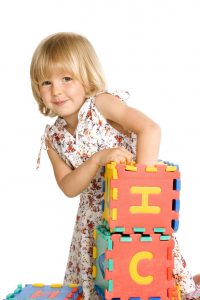Developmental Milestones
Understanding Developmental Milestones for Your Child
 Do you remember your child’s first smile? Or, when she rolled onto her tummy, crawled or walked for the first time? During the moment, you were probably more excited for her accomplishments and less focused on the fact that these special minutes were also important milestones in her development.
Do you remember your child’s first smile? Or, when she rolled onto her tummy, crawled or walked for the first time? During the moment, you were probably more excited for her accomplishments and less focused on the fact that these special minutes were also important milestones in her development.
Developmental milestones are physical skills and behaviors, such as described above, that are seen in your children as they grow. It’s important to realize that every child is different as is their developmental timeline. However, certain milestones should still occur within a certain age range. By understanding the normal range for when your child should reach a particular milestone you can support her development in specific areas as well as spot any potential delays.
If you do identify any delays or have concerns, discuss them with your pediatrician at your child’s next well visit. Be sure to talk with your child care provider as well to see if she has any concerns about your child’s progress so that you can take that into account when talking with your doctor.
Monitoring Your Child’s Milestones:
[su_list icon="icon: angle-right"]
- First, become familiar with all of the developmental milestones using one of the resources below.
- Next, print a developmental milestones chart for your child’s age and track her progress.
- Keep notes of any concerns or delays to discuss with your pediatrician; share your concerns with your child’s teacher to see if she has any feedback as well.
[/su_list]
BIRTH TO 1
[su_list icon="icon: angle-right"]
- Soon after birth your baby will begin to smile and respond to affection. Don’t forget to capture these precious moments on camera!
- Around three months, your baby should turns towards familiar sounds and make eye contact for fairly long periods of time.
- By his first birthday your child should be locating sources of voices with accuracy and understanding frequently used words such as: “all gone,” “no,” and “bye-bye.”
- Encourage your baby's development by allowing him to have supervised tummy-time.
- Make sure you are attending regular check-ups during your baby’s first year and discussing your child’s development with her pediatrician.
[/su_list]
AGE 1 TO 2
[su_list icon="icon: angle-right"]
- You’ll start to see your child become more excited to be in the company of other children and also start to imitate the behavior of others more.
- During this stage, your child will understand simple instructions such as: “give to daddy,” “kiss mommy,” and “stop.”
- Some of the skills your child will do this year is crawl on her hands and knees and pull up into standing independently at a stable surface.
- Soon your child will be walking alone, carrying toys while walking, beginning to run, standing on tip toes, and kicking balls.
- Around the age of two, your child should be able to unbutton large buttons and undress independently.
[/su_list]
AGE 2 TO 3
[su_list icon="icon: angle-right"]
- Your toddler will be able to follow two or three-phrase commands, sort objects by color or shapes, and imitate adults and playmates.
- Most 2-3 year olds can link four to five words together for simple sentences but may stutter while thinking about what to say.
- During this stage, expect your child to walk down stairs independently using one or both feet on each step.
- Between the ages of 2 and 3, most children can throw a tennis ball forward. Keep working on the catching!
- Your child will begin to understand opposites, such as: big/little, go/stop, hot/cold, and up/down.
[/su_list]
AGE 3 TO 4
[su_list icon="icon: angle-right"]
- Your child’s problem solving skills are really developing. Provide him with simple, large floor puzzles to put together to aid in his development!
- If you have not introduced your child to a tricycle or bike yet, now is the time! Both help to support his motor skills development.
- Around the age of 4, your child should be able to work zippers and put on her socks all by herself.
- This year, look for your child to begin copying some capital letters, drawing circles and squares, using scissors, and drawing people with two to four body parts.
- During this age, children love listening to stories. Ask them "why" questions while you are reading to further engage them.
[/su_list]
AGE 4 TO 5
[su_list icon="icon: angle-right"]
- Five-year-olds should be able to fix themselves cold cereal and pour some juice or milk, but you should still expect some spills. Encourage this act of independence.
- By the time your child enters kindergarten, she should be completely self-sufficient in the bathroom, though she still may not be proficient at wiping.
- At this age, your child’s pencil control is improving and he can color neatly inside the lines.
- Remember how much fun board games were when you were small? Your child is old enough now to follow simple rules in board or card games. Uno, anyone?
- Your child’s communication skills have really advanced in this last year. She should be able to speak clearly, understand and use future tense (such as “will be”) and tell a simple story using full sentences.
[/su_list]
Need More Information?
Centers for Disease Control Developmental Milestones American Academy of Pediatrics: HealthyChildren.org Ages and Stages University of Michigan Health System YourChild Development and Behavior Resources Growing Hands On Kids: Fine Motor Development for Ages 0 – 6
